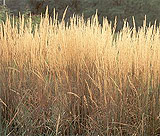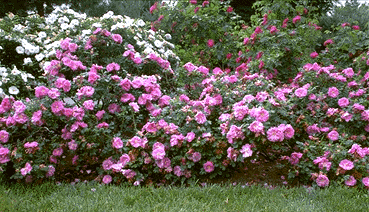It can be a limited palette,” says Paul Seeling, senior project manager at Three Rivers Landscape, Inc. in Minneapolis. “But a number of perennials can be left in the garden to add structure which add shadow and light play in winter.
![]()
Winter Gardening: When North Winds Blow
By Marcia Jedd
Harsh or mild, winter weather can be a wild card. No matter the conditions, a little extra planning adds winter delight to your landscape.
 Karl Foerster grass adds winter variety
Karl Foerster grass adds winter variety
Sipping lemonade on a late summer day in your Bermudas, the barren winter seems so far away. But planning a garden well suited to our Minnesota winters that avoids the doldrums and adds delight only requires a little extra effort. Of course good landscape design has all-season appeal. The challenge is Minnesota’s Zone 3 and 4 which requires hearty varieties. “It can be a limited palette,” says Paul Seeling, senior project manager at Three Rivers Landscape, Inc. in Minneapolis. “But a number of perennials can be left in the garden to add structure which add shadow and light play in winter.”
To plan for a garden with winter appeal, Seeling suggests some year-round gardening basics. “When trying to do your planning, you want variety in what the plants will produce and height variety, which is why some of the dwarf shrubs are so popular,” he says. Shape, texture and color all matter. Trees and shrubs provide background while smaller shrubs and plants act as hedging material. Well-chosen plants and grasses fill in the winter palette.
Evergreens
The evergreen tree is a classic for winter color and texture. Havens against the prevailing northwest winter wind, an evergreen such as a pine, fur or spruce placed appropriately away from your home can provide 10 percent or more in winter energy savings. Although common to Minnesota, one evergreen Seeling doesn't recommend is the Colorado blue spruce for its lack of hardiness and disease susceptibility as well as overbearing size potential. Seeling advises to plant evergreens, especially trees, prior to October 1 to allow enough time for rooting before winter sets in.
 When designing with shrubs, consider mature height and width but also color and form.
When designing with shrubs, consider mature height and width but also color and form.
Photo courtesy Minnesota Nursery & Landscape Association
Evergreen topiaries in shapes such as spirals and balls add winter delight. “There are no boundaries anymore. People have the time and interest to pursue these,” Seeling says. But gardeners should use caution in siting topiaries because of the drying effects of the harsh winds and burning effect of late winter sun.
Evergreen shrubs such as cedars and arborvitae offer a solid backdrop to a landscape, and complement berry plants and grasses, notes Jule Theiler, landscape designer with Landscape Renovations in Woodbury. Theiler recommends berry plants like the ornamental dwarf crab and the American highbush cranberry. “They give added appeal for holding berries through winter and attracting birds,” he says.
Shrubs
When designing with shrubs, consider mature height and width but also color and form. “Looking at the twig structure without the foliage can contribute interest in the winter as well as offer cover and protection for birds,” Seeling says. For winter appeal, Seeling recommends the red-twig dogwood shrub for its red stem color, available in native and cultivar varieties as well as dwarf.
A number of other shrubs lend unique shapes and delight to the winter garden. Lilacs and dwarf lilac shrubs offer a popular bridge from winter to spring. But if you like the unusual, Theiler recommends the twisted branches of Harry Lauder's Walking Stick that grows to about six feet. Resembling something Harry Potter would encounter, the contorted Walking Stick features interesting leaf forms and holds year-round curiosity.
For another fascinating winterscape form, Theiler and Seeler recommend the corkscrew or curly willow. “Curly willows have a nice twisted contorted appearance and are actually a Zone 5 (species) but given our mild winters, they’ve been doing well,” Theiler says. At about a six to eight feet mature height in Minnesota, the curly willow is known to die back and then regenerate. Theiler recommends heightening the winter drama by positioning willows as isolated plants in your landscape, if space provides.
Shrub Roses

Charles Albanel shrub rose
Shrub rose bush varieties have come up on their own in recent years offering a low-maintenance choice to their uppity counterparts. “People don’t want to be tied down with work of the hybrid tea rose,” Seeling says. Whether glistening with snow or dry, shrubs add form. Seeling suggests the low-growing Charles Albanel (one to two feet) for its ground cover and disease resistance. The taller Therese Bugnet cuts a graceful vase shape. The climbing John Davis and Louis Jolliet are known for their long canes that can be trained or tied to cover your arbor or trellis.
Grasses
Ornamental grasses won’t be overlooked in the winter because many varieties preserve their dried forms through much of the winter season. “Grasses have an attractive appearance in winter, swaying in the breeze or moving with the wind,” notes Mary Meyer, associate professor with the University of Minnesota at the Arboretum in Chanhassen. Grasses give an informal look year-round and have gained popularity with naturalistic gardening.
Grasses offer surprisingly sturdy structure. “They stand up but don’t fall down in the snow,” Meyer says, noting their appeal in combination with perennials or as a stand-alone specimen. She recommends our native switch grass and miscanthus, native to Asia and noted for its large plumes that last through winter. Both add tall forms to your garden. Meyer also recommends little bluestem. In fall, yellow-tan stems turn reddish-tan on this grass which grows to around three feet. All varieties bloom in September.
Another option is feather reed grass, a summer bloomer. Named by the Perennial Plant Association as the plant of the year for 2001, reed grass (Karl Foerster variety) shows off golden tan stems until early winter. Maintenance of these popular grasses is easy. Simply trim off old growth at ground level in late winter or early spring.
Late summer and fall is a great time to install plants. It allows for root systems to develop and plants to acclimate to cooler temperatures, without having to produce leaves and flowers, sparking spring growth. Finally, pergolas, trellises and other structures such as novelty copper sculptures can easily be left in year-round and enjoyed even dusted with snow.
Dakota County Master Gardener Laura Pesek contributed to this article.
© Marcia A. Jedd, 2002, All Rights Reserved.


